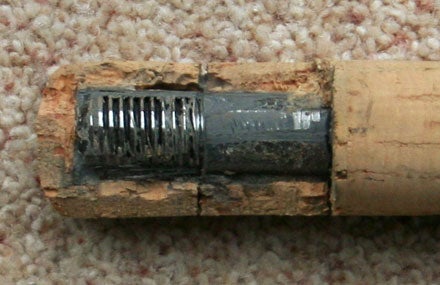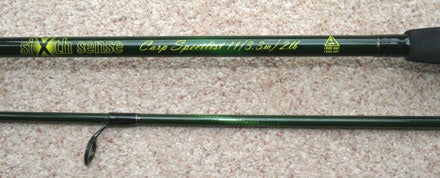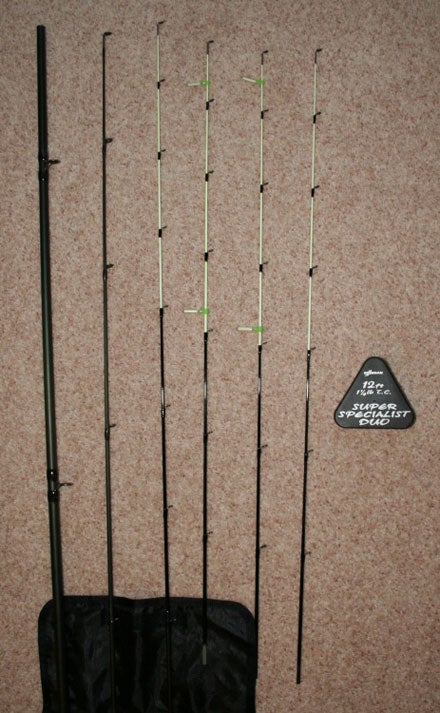| MARK WINTLE |
| Mark Wintle, an angler for thirty-five years, is on a quest to discover and bring to you the magic of fishing. Previously heavily involved with match fishing he now fishes for the sheer fun of it. With an open and enquiring mind, each week Mark will bring to you articles on fishing different rivers, different methods and what makes rivers, and occasionally stillwaters, tick. Add to this a mixed bag of articles on catching big fish; tackle design, angling politics and a few surprises. Are you stuck in a rut fishing the same swim every week? Do you dare to try something different and see a whole new world of angling open up? Yes? Then read Mark Wintle’s regular column. |
Buying Rods – You get what you pay forFor the next couple of articles I’m going to look at the tricky world of buying rods and reels. Scan the forums and you’ll often find anglers asking what sort of rod or reel to buy and how much to pay, so this week I’ll look at rods. Fishing rods are as much a consumer product as vacuum cleaners, cars and a multitude of other products. The quality of the design, the materials used and the way they are built dictate the overall quality, so that the maxim, ‘you get what you pay for’ holds true to a great extent. But before we get into the technicalities it’s worth thinking about why we buy rods. As anglers we often concentrate on one type of fishing, be it carp fishing, barbel fishing, piking, float fishing for roach. With any of these we usually try to get the best rod(s) that we can afford for that mainstream of our angling. But there are often times when we fancy a change, or are going to try something different when on holiday, and need a cheap rod that can do a very different job. There are those that simply must have the best, money being no object, and some that think that a new, better rod is the answer to their angling shortcomings. I’ve known people buy a new rod or two every month in their quest to improve their results when the reason for their failure is that they don’t know how to fish, but I digress. Other very successful anglers however, are the opposite extreme. One old, reliable but battered rod being pressed into service for a multitude of uses yet they hardly feel that their results suffer as a result. For some simply owning a really nice rod can give immense pleasure to the beholder, which partly explains the continuing fascination for lovingly restore built cane rods even if it’s not that efficient at catching fish. But this article is more about the rods on the rod racks in 2006, not the fraction of a percent that hanker after a Barder cane rod, so let’s talk about carbon fibre rods. First of all where are carbon rods made nowadays? The vast majority are made in the Far East, probably China. A few are made in Japan, and a few are made in the UK notably Harrison and Daiwa, although not of their rods. This separation of the design from the manufacture means that there is a heavy reliance on the designers ensuring that the product is exactly what is required. Those making it are often far removed from the situations in which it’ll be used so there needs to be plenty of practical fishing trials to get the design right. But just because a rod is made in the Far East doesn’t mean it’s no good, far from it, and the reduced manufacturing costs mean that usable rods are more affordable than ever. Probably the best rods of all come from the Diamura factory in Japan. This is where the Carbotec and the best Normark rods came from for many years until cost finally made them to uneconomic to make. What exactly is a ‘carbon’ rod made of? And why does it make such a difference? In very simple terms a woven carbon fibre cloth is impregnated with a resin, wrapped around a mandrel and baked. It may then be finished so that there is a smooth finish or left with the weave showing. And that’s your rod blank. A handle is fitted, rings whipped on and ferrules finished off. The carbon fibre cloth will always contain a small percentage of glass fibre scrim but by and large the finer the weave and the higher the percentage of carbon, the better quality the carbon itself will be. There are also different qualities of carbon. This means that for a given stiffness the rod is lighter and more responsive. So one of the differences between a mid range rod – for a match rod one costing say £ 100 – and a top of range one – costing over £ 200 should be in the quality of the carbon used. At the bottom end of the range (in match rod terms £ 15 to £ 20), the percentage of carbon drops alarmingly so that the rod shouldn’t really be described as a carbon rod, but as a composite one, as it is nearer to a fibreglass rod. Such rods will often feel top heavy and if so at least accept its limitations. We know what it’s made of but what of the action? Again price should be the guiding factor but it’s not always the case. All rod actions are something of a compromise. A fast, tip actioned rod, can be brilliant for casting, yet poor for playing fish. A softer, slow through action rod may be poor for casting, yet better for playing fish. That means looking at the waters you’ll be fishing before buying a rod. Carp rods are the classic example. There are waters where you’ll need to cast in excess of a hundred yards, with a sizeable lead, and need the power to control big carp, fish of thirty pounds and more. A fast-actioned rod with a test curve around 2.75lbs, might well fit the bill. But do you really need such a weapon for small commercial water, casting up to twenty yards for fish that rarely exceed ten pounds? What might be far more suitable is a typical Avon/barbel rod, with a test curve of around 1.5lbs, with a good through action. I compared some rods earlier this year, all were nominally 1.75lb test curve barbel rods by well-known makers, yet the actions varied enormously. One in particular was like a heavy poker yet another was light, well balanced with a progressive action (Shimano Nexave, since you ask). But how can you gauge a rod’s action in the shop? Unless you’re not bothered about what you buy, and prepared to buy mail order or simply choose it on impulse then I would recommend that you take the reel you intend using with it, loaded with line, and try the rod with the reel attached and the line threaded through the rings. This will give a far better idea of a rods action than pulling on the tip or bending it against the tackle shop ceiling. You will know what the rod feels like with a reel as well, and know that the reel will fit the fitting on the rod (not always the case; take particular care with some centre pins). On one occasion (exceptional but true) the tackle shop owner sent me down the river to fish with the rod, asking me to pay for it later if I liked it. But think carefully before buying it (as if I’ve never bought a rod on impulse and regretted it later!). Will it do the job you want it for? Or are you still unsure what you really want? Do you need to save up more money? Or look at more rods elsewhere? Actions In loading up the rod with line you’ll see whether the rod is tip actioned, more of a through action or one that will keep loading until the handle bends. One of the great features of the best modern rods is that the loading can be progressively increased without the rod locking up (locking up is the point where the rods stops bending ands the line breaks. Not that many years ago this was common but there are plenty of superb rods today that don’t lock up. Carbotec started it (though the best Normarks were pretty much already there as they shared the same designer), and a multitude of manufacturers have followed suit. I’d include Preston Innovations as one of the better ones but far from the only one. It’s that bending that absorbs the fight of a fish, especially when it’s under the rod tip and the stretch of the line is less apparent. When it comes to casting it’s all about loading the blank up with the energy and releasing it. Improved carbon fibre materials and resins mean that casting rods are much better for playing fish than the ultra fast taper sticks of yesteryear, so don’t feel compelled to buy some beast of a rod when a much better tool is available. Don’t be afraid to take the rod apart. Check out the ferrules for fit and ease of use. One long rod I own has tight ferrules but a brilliant playing action, and I’ll just have to accept its shortcomings until the ferrules eventually bed in. When the rod is apart, check the balance of the handle. Does it feel like there’s a great lump of lead in the end of the butt? Do you really want a rod that’s so badly designed it needs to be made heavier to address balance problems?
Think about length; rods seem to be getting ever longer, not always to our advantage. I still think there’s a place for shorter rods as well, or at least rods that pack up shorter than over 6ft (two piece twelve footers). I’d like to see at least the option of 11 footers (I did try to buy to buy the 11 foot FM Concept Rod but couldn’t locate one, settling for an Interceptor instead). Cheap and cheerful There is a time to buy cheap and cheerful. Need a telescopic for holiday fishing, or a rod for occasional piking/carping? It’s hard to justify £ 200 for the best that money can buy when, provided you look hard enough, a decent rod that will do, can be had for a fraction of that. I found a carp rod last year for £ 30. Only 2lb test curve and 11ft, but light and tough with a good action. The tackle shop owner reckoned they fly out the door in the school holidays. And why not at that price and quality. So what if the name on the rod says ‘Specilist’? It’s proved a pleasant rod to use and abuse, most recently for chucking mackerel feathers 80 yards with a 2oz bomb. A medium feeder rod bought for Method feeding work, proved far from up to chucking method feeders 60 yards. It’s quiver tip falls out unless stuck in with grass and the general quality of finish is tacky yet it has proved a gorgeous chub rod, and handled some decent barbel as well.
But it’s got a famous name on the butt The marketing concept of a famous angler putting his name to a rod(s) is hardly new. The implication is that the ‘name’ had input to the design. Sometimes that’s true but not always. Make no mistake this idea sells rods, although I think it’s better to ignore the ‘name’ and judge it on its merits alone. If you like the rod and believe it’s good value, and suitable for what you want then by all means buy it. But don’t think that the ‘name’ is a guarantee of quality, or that the ‘star’s’ success will automatically rub off on you. As has been discussed with the John Wilson rods, the specification can change over the years, and what was originally a brilliant rod at the time continues to outsell other better rods on name alone despite significant changes to the design and quality. Combination rods
Again, a far from new concept but improved by modern rod making. It’s probably true that there is usually a best rod in the combinations available, and that sometimes extra extensions can unbalance a rod or badly affect the action. So check out the different tips and actions and decide whether you’ll ever use all the combinations. With some rods, especially Avon and barbel type rods, it’s usual to get a ‘normal’ top and a tip with quivertip(s). Fittings, rings, handles Last but not least look at the fittings; check your reels fit snugly, that the rings are secure and aligned, and that the handle feels comfortable, and looks durable. This has been an all too brief look at a vast subject but I hope it’ll make you think before buying your next rod! Next week I’ll look at buying reels for coarse fishing |













